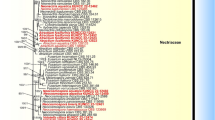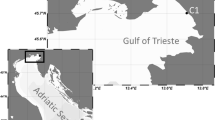Abstract
Macroscopic fuzzy clumps of green filaments resembling filamentous algae were found on multiple sampling occasions in the water close to the shore of the extremely acidic (pH < 3) Hromnice Lake in Czechia. Microscopic investigation revealed that these filaments were moss protonemata. In order to identify the moss, we sequenced chloroplast (rbcL), mitochondrial (nad5), and nuclear (ITS2) molecular markers of these filaments. In addition, we sampled adult mosses growing on the wet substrate soaked with lakewater. The sequences of protonemata matched those of the adults, which were morphologically identified as Dicranella sp. Phylogenetic analysis of the rbcL gene showed a sister relationship with D. heteromalla, generally known for growing in acidic habitats, and other protonemata occurring in acidic rivers in Japan. The nad5-based phylogeny revealed that the studied protonemata belonged to the species D. cerviculata, and the same taxonomic affiliation was confirmed by the ITS2 rDNA sequence and its secondary structure. The extreme environment of Hromnice Lake prevents the further development of protonemata which, in turn, are capable of surviving acidic conditions in the prolonged protonemal stage. Due to their macroscopic similarity to filamentous algae, protonemata might be more common in extremely acidic waters than originally thought.




Similar content being viewed by others
References
Altschul SF, Madden TL, Schäffer AA, Zhang J, Zhang Z, Miller W, Lipman DJ (1997) Gapped BLAST and PSI-BLAST: a new generation of protein database search programs. Nucleic Acids Res 25:3389–3402
Bonfim Santos M, Fedosov VE, Hartman T, Ignatov M, Siebel H, Stech M (2017) Dicranella, a case study of misunderstood diversity of inconspicuous haplolepideous mosses. In: XXI Cryptogamic Botany Symposium; 20–24 June 2017, Aranjuez, Spain. Abstract SIST-08, p 100
Darty K, Denise A, Ponty Y (2009) VARNA: interactive drawing and editing of the RNA secondary structure. Bioinformatics 25:1974–1975
Falagán C, Sánchez-España FJ, Johnson DB (2014) New insights into the biogeochemistry of extremely acidic environments revealed by a combined cultivation-based and culture-independent study of two stratified pit lakes. FEMS Microbiol Ecol 87:231–243
Fedosov VE, Fedorova AV, Fedosov AF, Ignatov MS (2016) Phylogenetic inference and peristome evolution in haplolepideous mosses, focusing on Pseudoditrichaceae and Ditrichaceae s. l. Bot J Linn Soc 181:139–155
Francis PC, Petersen RL (1989) Assessment of toxicity of heavy metal ion combinations on spore germination and protonemal growth of Polytrichum commune. Bryologist 92:60–67
Geller W, Schultze M, Kleinmann B, Wolkersdorfer C (2013) Acidic pit lakes: the legacy of coal and metal surface mines. Springer, Heidelberg
Hall TA (1999) BioEdit: a user-friendly biological sequence alignment editor and analysis program for Windows 95/98/NT. Nucleic Acids Symp Ser 41:95–98
Higuchi S, Kawamura M, Miyajima I, Akiyama H, Kosuge K, Kato M, Nozaki H (2003) Morphology and phylogenetic position of a mat-forming green plant from acidic rivers in Japan. J Plant Res 116:461–467
Hrdinka T, Šobr M, Fott J, Nedbalová L (2013) The unique environment of the most acidified permanently meromictic lake in the Czech Republic. Limnologica 43:417–426
Itouga M, Hayatsu M, Sato M, Tsuboi Y, Kato Y, Toyooka K, Suzuki S, Nakatsuka S, Kawakami S, Kikuchi J, Sakakibara H (2017) Protonema of the moss Funaria hygrometrica can function as a lead (Pb) adsorbent. PLoS ONE 12:e0189726
Katoh K, Rozewicki J, Yamada KD (2017) MAFFT online service: multiple sequence alignment, interactive sequence choice and visualization. Brief Bioinform. https://doi.org/10.1093/bib/bbx108
Kleeberg A, Schubert H, Koschorreck M, Nixdorf B (2006) Abundance and primary production of filamentous green algae Zygogonium ericetorum in an extremely acid (pH 2.9) mining lake and its impact on alkalinity generation. Freshw Biol 51:925–937
Koetschan C, Hackl T, Müller T, Wolf M, Förster F, Schultz J (2012) ITS2 database IV: interactive taxon sampling for internal transcribed spacer 2 based phylogenies. Mol Phylogenet Evol 63:585–588
Kučera J, Váňa J, Hradílek Z (2012) Bryophyte flora of the Czech Republic: updated checklist and Red List and a brief analysis. Preslia 84:813–850
Lanfear R, Frandsen PB, Wright AM, Senfeld T, Calcott B (2017) PartitionFinder 2: new methods for selecting partitioned models of evolution for molecular and morphological phylogenetic analyses. Mol Biol Evol 34:772–773
Lessmann D, Fyson A, Nixdorf B (2000) Phytoplankton of the extremely acidic mining lakes of Lusatia (Germany) with pH < 3. Hydrobiologia 433:123–128
Manhart JR (1994) Phylogenetic analysis of green plant rbcL sequences. Mol Phylogenet Evol 3:114–127
Marshall NL (1919) Mosses and lichens: a popular guide to the identification and study of our commoner mosses and lichens, their uses, and methods of preserving. Garden City, New York
Moser M, Weisse T (2011) The most acidified Austrian lake in comparison to a neutralized mining lake. Limnologica 41:303–315
Pociecha A, Bielańska-Grajner I, Szarek-Gwiazda E, Wilk-Woźniak E, Kuciel H (2018) Rotifer diversity in the acidic pyrite mine pit lakes in the Sudety Mountains (Poland). Mine Water Environ 37:518–527
Rachna P, Vashistha BD (2017) Effects of heavy metals on protonemal growth and bud formation in the moss Hydrogonium arcuatum. Agric Sci Digest 37:117–121
Rambaut A (2007) Figtree, a graphical viewer of phylogenetic trees. http://tree.bio.ed.ac.uk/software/figtree/
Rambaut A, Drummond AJ, Xie D, Baele G, Suchard MA (2018) Posterior summarisation in Bayesian phylogenetics using Tracer 1.7. Syst Biol 67:901–904
Reuter JS, Mathews DH (2010) RNAstructure: software for RNA secondary structure prediction and analysis. BMC Bioinform 11:129
Robinson H, Reed CF (1987) Notes on the distribution of the Bartleya expression of Dicranella cerviculata in Appalachian coal fields. Bryologist 90:43–44
Ronquist F, Teslenko M, van der Mark P, Ayres DL, Darling A, Höhna S, Larget B, Liu L, Suchard MA, Huelsenbeck JP (2012) MrBayes 3.2: efficient Bayesian phylogenetic inference and model choice across a large model space. Syst Biol 61:539–542
Seibel PN, Müller T, Dandekar T, Wolf M (2008) Synchronous visual analysis and editing of RNA sequence and secondary structure alignments using 4SALE. BMC Res Notes 1:91
Stamatakis A (2014) RAxML version 8: a tool for phylogenetic analysis and post-analysis of large phylogenies. Bioinformatics 30:1312–1313
Wehr JD, Whitton BA (1983) Aquatic cryptogams of natural acidic springs enriched with heavy metals: the Kootenay Paint Pots, British Columbia. Hydrobiologia 98:97–105
White TJ, Bruns T, Lee S, Taylor J (1990) Amplification and direct sequencing of fungal ribosomal RNA genes for phylogenetics. In: Innis M, Gelfand D, Sninsky J, White T (eds) PCR protocols: a guide to methods and applications. Academic, Orlando, pp 315–322
Whitton BA, Diaz BM (1981) Influence of environmental factors on photosynthetic species composition in highly acidic waters. Verh Internat Verein Limnol 21:1459–1465
Wolf M, Chen S, Song J, Ankenbrand M, Müller T (2013) Compensatory base changes in ITS2 secondary structures correlate with the biological species concept despite intragenomic variability in ITS2 sequences—a proof of concept. PLoS ONE 8:e66726
Zettler ALA, Gómez F, Zettler E, Keenan BG, Amils R, Sogin ML (2002) Microbiology: eukaryotic diversity in Spainʹs River of Fire. Nature 417:137
Acknowledgements
This study was funded by the National Museum in Prague, grant no. P17/01IG-BA. We thank Jan Kučera (Department of Botany, University of South Bohemia, Czechia) for reading the draft of the manuscript.
Author information
Authors and Affiliations
Corresponding author
Additional information
Publisher's Note
Springer Nature remains neutral with regard to jurisdictional claims in published maps and institutional affiliations.
Handling Editor: Yoshikuni Hodoki.
Electronic supplementary material
Below is the link to the electronic supplementary material.
10201_2019_570_MOESM1_ESM.docx
Supplementary material 1 (DOCX 8670 kb). Fig. S1. Hromnice Lake formed as a consequence of the mining of pyritic shales. Photo P.J. Juračka. Fig. S2. Macroscopic clumps of protonemata occurring in the water close to the shore. Adult Dicranella grew on the wet substrate beneath. Photo P.J. Juračka. Fig. S3. Cultivation of protonemata in a Petri dish
Rights and permissions
About this article
Cite this article
Barcytė, D., Fott, J. & Nedbalová, L. A molecular approach to identification of protonemata helps assess biodiversity of extremely acidic freshwaters. Limnology 20, 225–231 (2019). https://doi.org/10.1007/s10201-019-00570-6
Received:
Accepted:
Published:
Issue Date:
DOI: https://doi.org/10.1007/s10201-019-00570-6




